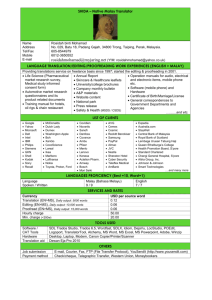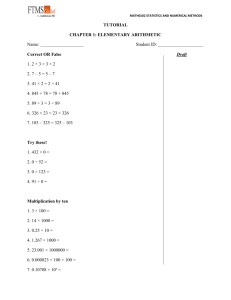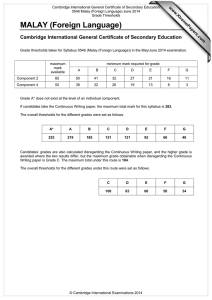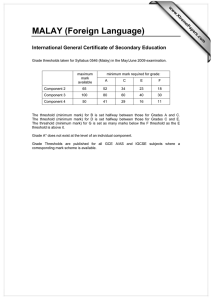CAN CLIMATIC RESPONSE BECOME AN ESSENTIAL LINGUA FRANCA FOR MALAY ARCHITECTURE?
advertisement
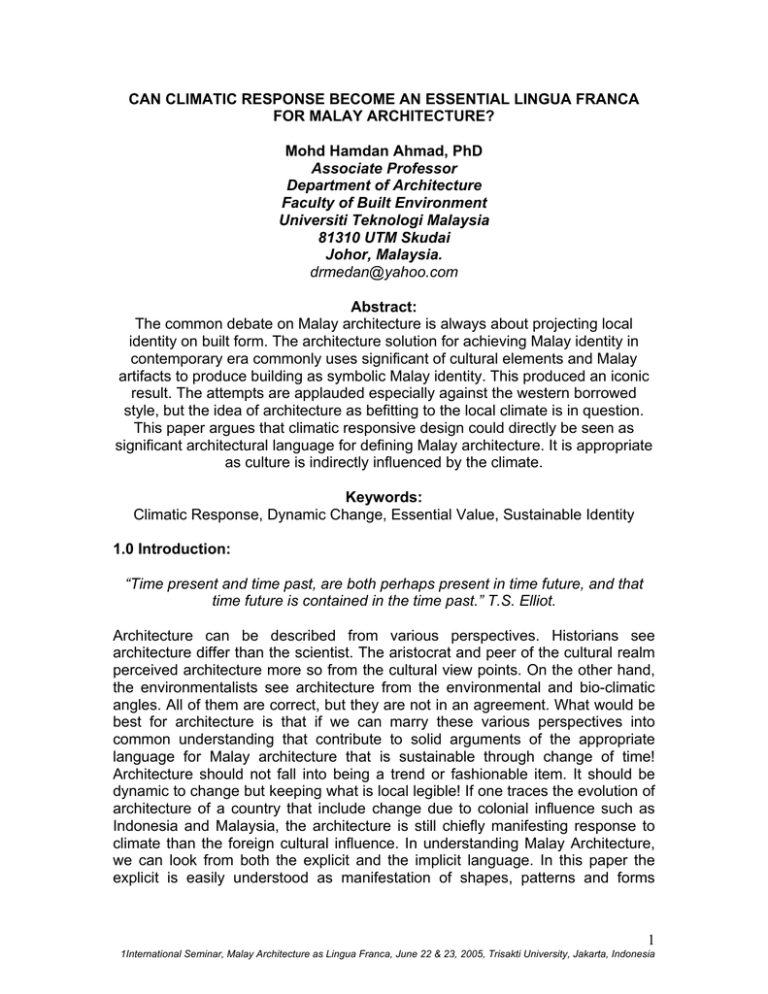
CAN CLIMATIC RESPONSE BECOME AN ESSENTIAL LINGUA FRANCA FOR MALAY ARCHITECTURE? Mohd Hamdan Ahmad, PhD Associate Professor Department of Architecture Faculty of Built Environment Universiti Teknologi Malaysia 81310 UTM Skudai Johor, Malaysia. drmedan@yahoo.com Abstract: The common debate on Malay architecture is always about projecting local identity on built form. The architecture solution for achieving Malay identity in contemporary era commonly uses significant of cultural elements and Malay artifacts to produce building as symbolic Malay identity. This produced an iconic result. The attempts are applauded especially against the western borrowed style, but the idea of architecture as befitting to the local climate is in question. This paper argues that climatic responsive design could directly be seen as significant architectural language for defining Malay architecture. It is appropriate as culture is indirectly influenced by the climate. Keywords: Climatic Response, Dynamic Change, Essential Value, Sustainable Identity 1.0 Introduction: “Time present and time past, are both perhaps present in time future, and that time future is contained in the time past.” T.S. Elliot. Architecture can be described from various perspectives. Historians see architecture differ than the scientist. The aristocrat and peer of the cultural realm perceived architecture more so from the cultural view points. On the other hand, the environmentalists see architecture from the environmental and bio-climatic angles. All of them are correct, but they are not in an agreement. What would be best for architecture is that if we can marry these various perspectives into common understanding that contribute to solid arguments of the appropriate language for Malay architecture that is sustainable through change of time! Architecture should not fall into being a trend or fashionable item. It should be dynamic to change but keeping what is local legible! If one traces the evolution of architecture of a country that include change due to colonial influence such as Indonesia and Malaysia, the architecture is still chiefly manifesting response to climate than the foreign cultural influence. In understanding Malay Architecture, we can look from both the explicit and the implicit language. In this paper the explicit is easily understood as manifestation of shapes, patterns and forms 1 1International Seminar, Malay Architecture as Lingua Franca, June 22 & 23, 2005, Trisakti University, Jakarta, Indonesia whilst the implicit is about the soul, the spatial quality and the enjoyment of the whole architecture – the Malay built form and the natural environment. 2.0 Climate and the Instantaneous Response: Architecture is manifested into a built form for the enjoyment of the user. The traditional architecture had exhibited and reflected clear understanding of the contemporary context and quality of life during that time. In a way architecture had been used as a measure or reflection of a civilization. If we looked at the various civilizations, the architecture reflected the clear response to climate in achieving controlled indoor environment whilst at the same time reflecting the artistic influence. In parallel, their clothing also was cleverly an intelligent response to the climate. The clothing in this case is being the protection of the body against the outdoor condition, whilst the architecture or building is another mean of protection, shelter against the bigger environment. We use to know people from how they dress, thus portraying identity of where they come from. What we change is how we shape the dress but the comfort and the fabric that most suitable to the climatic condition to good fashion designer are still essential! Our clothes were loose and baggy, made out of cotton, letting good ventilation and protect from direct conduction of heat to the skin. It is still possible when form and figure become essential to appreciating beauty, but we become less comfortable. However, we still maintain the identity. Problem is when we start buying foreign clothing and dyeing our hair that others could not figure out us instantaneously. We loose our identity when we start changing for the sake of changing without maintaining what is essential. Can climatic understanding is that essential value to be kept? The same thing applies to architecture. Traditional architecture cleverly appreciate climate which in turn become part of the cultural understanding in creating built form. For example, the construction technology depicted the available technology at that time but somehow illustrated an accurate prediction of controlling, filtering and responding to outdoor climate. The outdoor expressions were responding to the exposure of the building surfaces or envelopes and their aesthetic effect to the sunlight and even the sky condition. For example, in the hot and clear sky condition, the thickness of the wall of large cut stone and rubble illustrated the available material and technology then, but genius enough to protect inhabitants from the harsh outdoor climate. The exterior façade with small openings filter the glaring sunlight but the texture provide interesting shadow cast that enhanced the aesthetic of large wall surfaces. The same respond is also true for the other climates such as Mediterranean with strong colonnaded façade that is aesthetically outstanding with the outdoor light. What about the igloo? No modern building can emulate igloo, a simple structure made of the only available material that in itself a splendid form in response to the extreme climate but depicted the life and culture of the place where people basically stay indoor and two weeks of the year when the sun can keep them 2 2International Seminar, Malay Architecture as Lingua Franca, June 22 & 23, 2005, Trisakti University, Jakarta, Indonesia warm, people enjoy the outdoor and that is the time the igloo is self-demolished! What about our Malay Architecture? 3.0 The Implicit and Explicit of Malay Traditional Architecture: When we discussed about the Malay Traditional Architecture, the picture that comes to our mind is a traditional kampong house that sits comfortably within its surrounding. It has a pitch roof to block the heat from the sun and shed the rain when it pours. The facades are recessed and almost hidden behind the long roof overhangs. It has large openings that allow maximum ventilation. The walls are sometime operable or open-able allowing flexibility of uses and function from comfort to visual and privacy. The floor is raised on stilt making no contact with the ground, again allowing natural ventilation and avoiding conduction of heat from the ground. The sleeping areas face east and front verandah always avoiding facing west. They are loosely arranged allowing good air movements around building. The surrounding enhances the sheltering from the hot sun having trees indirectly as natural filter. The indoor is as open plan as possible, with loosely arrange furniture creating transparency of light and ease the natural ventilation. The interior sometime is visually gloomy providing sense of coolness against the hot outside environment. The Malay Traditional Architecture is a reflection of careful understanding of our people towards their environment even without architect! This is implicit language that we normally misplaced. The interesting point is that the same approach and constructional technique are being repeated elsewhere as solution to tropical climates. Slight variations introduced and normally involved the roof forms (see figure 1 for East Malaysia). From the figure we can say that what is essentially responsive to climate is being maintained, and that expression of how cultural symbols or beliefs are now integrated creating that new regional variation of architectural form? If we refer to figure 2, the same situation applies to the South East Asian and South Sea traditional solutions. What we see as what others would clearly notice is the uniqueness of the roof forms, and that is what we, architect always cling on and grandiose about. Malay identity as stylistic form! This is the explicit Malay architectural language approach. 4.0 Issues on Contemporizing Traditional Architecture: There have been many attempts to contemporize Malay Traditional Architecture into various building type and to some extent it can be abusive. The fine examples of Malay Architecture that we have are mostly at the scale of houses, mosques and palaces. The context then was different where greenery abundance against now day hard landscape. The contemporary need has changed. Our life style also changes. We cannot afford having single space anymore as privacy becoming more important. Technology and the way we built had also changed significantly. We cannot expect to duplicate, copy and blow-up the traditional scale into what we desire. It will not work. The alarming concern is 3 3International Seminar, Malay Architecture as Lingua Franca, June 22 & 23, 2005, Trisakti University, Jakarta, Indonesia that we had failed to acknowledge the implicit language of Malay Architecture that we can transform into larger and more complex building typology and used. Instead our attempts were basically a pretentious Malay Traditional Architecture forms from Malay houses into high rises! The results were total mismatch of scale, proportion and conception of what Malay Traditional Architecture has preached. These fail attempts forecast that explicit Malay Traditional architecture language which we thought easy may not be the one that will sustain the language or the lingua franca of Malay Architecture. 5.0 Proposition: We cannot bring back what we have lost and changed. We can just repair the damaged done. Thus, we cannot afford to bring back the romance of Traditional Architecture into its former setting and natural context. We know that tackling the crisis of identity from the explicit has not been well resolved. Of course it is probably better than the western imported idealism of universal and globalization. However, what we see is mostly iconic and symbolic abstraction into our city built forms. Therefore, we have yet to exhaustively explore the possibilities. What I can propose is that we focus more on the implicit language of Malay Architecture. If it was one an intelligent spatial quality that is responsive and friendly to the natural environment, then we have to start back from this approach. The only different is that we need to understand and consider the changes in our contemporary environment. Also village can turn into city, whilst city change into metropolitan. All this change must be addressed. Only then we can assure that the Malay Architecture language will sustain, evolve and appropriate through time. If Traditional Malay Architecture works well when blending with nature, then how can we make it work with harsher environment that we are experiencing today? Could it be Corbusier machine for living? Or is the organic Wright idea right? What about our own bio-climatic idea of Dr Ken Yeang? Can we still cling to the application of batik, songket and ukiran on our facades or tengkolok and songkok on top of buildings? What I sense is that our contemporary architecture has gone to war with nature! We must aspire that our next attempt is an act of friendly rekindle with our surrounding. Explore the implicit language of Malay Architecture, and integrate the explicit. Let’s pray it will work! 6.0 Conclusion: Architecture is too substantial to become an artifact. Architecture is about life, a public art that will have to be experienced by people. Architecture must fit to context. We can put Traditional Architecture into a frozen state or place into a protected inheritance of past excellence under heritage acts for future generation to appreciate. We can turn many of our heritages into museums. But what is more important is to continuously sustain the fundamental nature that is the 4 4International Seminar, Malay Architecture as Lingua Franca, June 22 & 23, 2005, Trisakti University, Jakarta, Indonesia language of climatic understanding into contemporary solution. Further, we should observe the soul of the traditional solution that includes the understanding of force of nature and its reward into contemporary solution. We must keep the essential and then only integrate the translation of other intentions of Malay identity into the solution. Beauty is not just aesthetic appearance but enjoyment of the whole architecture. Lets not grandiose what is visibly Malay identity from outside but the inner quality of life that Malay Architecture can provide. Reference: 1. Alexander Tzonis, Liane Lefaivre and Bruno Stagno Editors, Tropical Architecture: Critical Regionalism in the Age of Globalization, WileyAcademy & Fonds, Netherland-UK, 2001. 2. Chris Abel, Architecture & Identity: Towards a Global Eco-Culture, Architectural Press, 1997. 3. Lim Jee Yuan, The Malay House: Rediscovering Malaysia’s Indigenous Shelter System, Institut Masyarakat, Malaysia, 1987. 4. Hassan Fathy, Natural Energy and Vernacular Architecture: Principles and Exampleswith Reference to Hot Arid Climate, The University of Chicago Press Ltd., London, 1986. 5. Sahutan Regionalisme dalam Identiti Senibina di Malaysia: Adaptasi Awal Tradisi Modenisme 1950-1980, Mohamad Tajuddin Rasdi and Gurupiah mursib, Jurnal Alam Bina, jilid 06 No 02 Disember 2004. 6. Milton Tan, Design Case-based Reasoning with the Multimedia architectonics of Changing Traditions in Asia, Journal of Southeast Asian Architecture, Volume 1, School of Architecture, National University of Singapore, September 1996. 5 5International Seminar, Malay Architecture as Lingua Franca, June 22 & 23, 2005, Trisakti University, Jakarta, Indonesia Figure 1: Slight variations introduced and normally involved the roof forms (in Malay Traditional Architecture) for different region in West Malaysia. Source: Ref 3 6 6International Seminar, Malay Architecture as Lingua Franca, June 22 & 23, 2005, Trisakti University, Jakarta, Indonesia Figure 2: Similar trends of variation in forms in South East Asian and South Sea Traditional Architecture solutions. We can feel the spatial delight and the whole resultant ambience. Source: Ref 6 7 7International Seminar, Malay Architecture as Lingua Franca, June 22 & 23, 2005, Trisakti University, Jakarta, Indonesia

